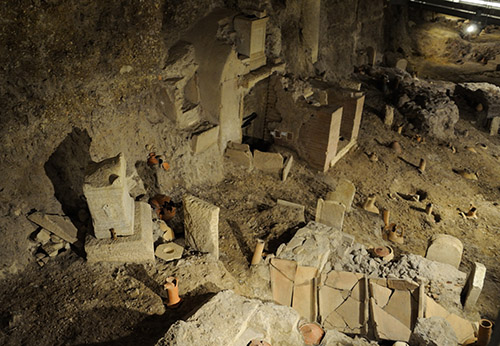The Day of the Dead in the Ancient Rome: from Lemuralia to Halloween
The Halloween festivity with its masks and “tricks and treat” tradition is approaching and as every year here in Italy there are a lot of debate since “it’s not part of our culture”.
That’s true.
Halloween comes from the pagan-celtic festivity of Samhain traditionally held between the evening of the 31st of October and the 1st of November to celebrate the beginning of winter season: during this night the passage to the Underwold opened, letting the souls of the dead, but also pagan gods and nature spirits enter into our world
Offerings of food were left outside houses to feed them and propitiate the survival of the family during the long and cold winter.
Trick-or-treating tradition may have come from the will of impersonating the spirits and collect offering from them, using as lantern a carved turnip or pumpkin. (have you ever seen a carved turnip? It’s so scary!
And what about the Ancient Rome?
According to the Roman calendars, there were two different festivals dedicated to the spirits of the deads: the Parentalia and Feralia in February for the good spirits (manes) and the Lemuralia in May for the wicked ghosts (Lemures).
Manes were peaceful and good spirits of the ancestors living in the underwold, with strict and frequent contacts with their family, since they were believed to live nearby the tomb, existing to protect their kin.
That’s the reason why, each tomb has a dedication to the Manes (Dis Manibus), followed by the name of the dead, in genitive.
But they need to be satisfied to stay good. They need gifts.
So graves, mausoleums and tombs had always a small area for rituals, where the relatives could leave offerings or do small libations, usually during the funeral or Parentalia .

During those libations, the family of a dead one poured liquids directly on the tomb (usually there was a small hole or a tube in the ground for this ryte).
We know more about Roman funerary rites thanks to archaeological excavations as the Necropolis of the Triumphalis Road at the Vatican Museums.
If the Manes were not happy with the funeral or the offerings, they can turn into Lemures, vengeful spirits who would hunt the family and the house.
For them there was a separate festival, in May the Lemuria: in those days, at midnight the pater familias had to feed the spirit, performing some kind of exorcism.
Walking barefoot he had to throw out black beans, bannish the spirit from his house.
The most important day of the Lemuralia was on May the 13th, a date picked by Pope Bonifax IV in 600 to convert the Pantheon into a church, starting a new festivity, all Saints Day, an attempt made to delete the memory of the old pagan festival.
The choice of moving the original festivity of the All Saints from May to the 1st of November was again to “christianize” also the Celtic festival, turning the Samhain into All Hallows’ Eve (Halloween).
So we do not have Halloween in Rome, but there is a link between Simhain and All Saints’ day: a connection made by legends about spirits and ghosts and passage to the underwold in the Ancient Rome.